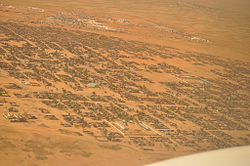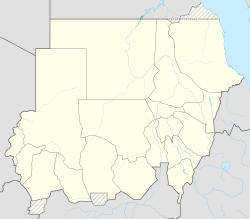Al-Fashir
Al-Fashir
الفاشر | |
|---|---|
City | |
 Aerial view of Al-Fashir | |
| Coordinates: 13°37′50″N 25°21′0″E / 13.63056°N 25.35000°E | |
| Country | |
| State | North Darfur |
| Population (2009) | |
• Total | 500,000[1] |
Al-Fashir or El Fasher (Arabic: الفاشر, romanized: al-Fāshir) is the capital city of North Darfur, Sudan. It is a city in the Darfur region of southwestern Sudan, 195 kilometres (121 mi) northeast of Nyala, Sudan.[2] A historical caravan post, Al-Fashir is located at an elevation of about 700 metres (2,300 ft).[2] The city serves as an agricultural marketing point for the cereals and fruits grown in the surrounding region. Al-Fashir is linked by road with both Geneina and Umm Keddada. Al-Fashir had 264,734 residents as of 2006[update], an increase from 2001, when the population was estimated to be 178,500.[2] UN Habitat reported a population of 500,000 for al-Fashir in 2009, attributing the increase to refugees and economic migrants.[1]
Al Fashir University was created in 1990 by decree of President Omar Hassan Ahmed Bashir, and was officially opened in February 1991 in premises west of El Fasher Airport and south of the El Fashir School.[3]
History
[edit]Late in the 18th century, Sultan Abd-er-Rahman el-Rashid of the Sultanate of Darfur moved his itinerant court (fashir) to a site called Rahad Tendelti while campaigning in the region of northern Darfur as it was a superb spot for a settlement and grazing; eventually the site was renamed to al-Fashir.[4][5] A town developed around the sultan's palace grounds.[2]

Fighting known as the Battle of El Fasher commenced in April 2023.[6]
Geography
[edit]Climate
[edit]Al-Fashir has a hot arid climate (Köppen BWh) with three distinct seasons. There is a bone-dry and relatively "cool" season from October to February when temperatures are merely hot by afternoon and cool in the mornings, which gives way to a sweltering and equally arid "hot season" from March to May with high temperatures around 38 °C or 100 °F and morning lows of 21 °C or 70 °F. The Sahelian monsoon arrives in June and lasts until September, creating a short wet season that produces virtually all the year's rainfall of around 210 millimetres or 8.3 inches, accompanied by much higher humidity than during the remainder of the year.
| Climate data for Al-Fashir (1991–2020 normals, extremes 1961–2020) | |||||||||||||
|---|---|---|---|---|---|---|---|---|---|---|---|---|---|
| Month | Jan | Feb | Mar | Apr | May | Jun | Jul | Aug | Sep | Oct | Nov | Dec | Year |
| Record high °C (°F) | 39.5 (103.1) |
41.0 (105.8) |
42.2 (108.0) |
43.0 (109.4) |
46.3 (115.3) |
44.2 (111.6) |
41.7 (107.1) |
43.5 (110.3) |
41.5 (106.7) |
40.0 (104.0) |
38.4 (101.1) |
36.7 (98.1) |
46.3 (115.3) |
| Mean daily maximum °C (°F) | 29.5 (85.1) |
32.5 (90.5) |
35.5 (95.9) |
38.2 (100.8) |
39.2 (102.6) |
38.9 (102.0) |
36.3 (97.3) |
34.1 (93.4) |
35.9 (96.6) |
36.2 (97.2) |
33.1 (91.6) |
30.1 (86.2) |
35.0 (95.0) |
| Daily mean °C (°F) | 20.3 (68.5) |
23.0 (73.4) |
26.3 (79.3) |
29.4 (84.9) |
31.3 (88.3) |
31.7 (89.1) |
30.1 (86.2) |
28.5 (83.3) |
29.4 (84.9) |
28.8 (83.8) |
24.3 (75.7) |
21.0 (69.8) |
27.0 (80.6) |
| Mean daily minimum °C (°F) | 11.1 (52.0) |
13.6 (56.5) |
17.1 (62.8) |
20.6 (69.1) |
23.5 (74.3) |
24.5 (76.1) |
23.9 (75.0) |
22.9 (73.2) |
22.9 (73.2) |
21.3 (70.3) |
15.6 (60.1) |
11.8 (53.2) |
19.1 (66.4) |
| Record low °C (°F) | 0.7 (33.3) |
1.4 (34.5) |
6.5 (43.7) |
8.2 (46.8) |
12.8 (55.0) |
15.7 (60.3) |
15.6 (60.1) |
13.5 (56.3) |
15.0 (59.0) |
7.1 (44.8) |
5.6 (42.1) |
2.0 (35.6) |
0.7 (33.3) |
| Average precipitation mm (inches) | 0 (0) |
0 (0) |
0 (0) |
1 (0.0) |
6.5 (0.26) |
16.4 (0.65) |
60 (2.4) |
102.9 (4.05) |
28.9 (1.14) |
3.8 (0.15) |
0 (0) |
0 (0) |
219.5 (8.64) |
| Average precipitation days (≥ 1.0 mm) | 0 | 0 | 0 | 0.2 | 0.8 | 2.2 | 6.1 | 8.8 | 3.4 | 0.6 | 0 | 0 | 22 |
| Average relative humidity (%) | 24 | 19 | 16 | 17 | 23 | 32 | 47 | 57 | 44 | 28 | 24 | 24 | 30 |
| Mean monthly sunshine hours | 306.9 | 274.4 | 291.4 | 282.0 | 266.6 | 231.0 | 213.9 | 213.9 | 237.0 | 285.2 | 306.0 | 313.1 | 3,221.4 |
| Source: NOAA[7][8] | |||||||||||||
Economy
[edit]Due to the nearby Abu Shouk[9] and Al Salam[10] IDP camps with the influx of humanitarian aid from the United Nations as a result of the Darfur crisis, the city has experienced a significant economic and population boom. Rents and retail sales increased, including the selling of bottled water and the opening of a pizza parlor to cater to the demand from western aid workers. The number of gas stations has tripled in three years as a result of the increase in the amount of automobiles in the city. Employment opportunities also increased as the United Nations offered jobs to citizens. Economics analyst Adam Ahmed stated that the "people [of Al-Fashir] are beginning to think in a more business-minded way" to make the most of their situation.[11]
See also
[edit]- Chad – border country near Nyala, Sudan.
- History of Darfur
Notes
[edit]References
[edit]- ^ a b "Profile of El Fasher Town and Abu Shouk IDP Camp" (PDF). UN Habitat. Retrieved 6 December 2023.
- ^ a b c d "Al-Fashir" (description), Encyclopædia Britannica, 2007, webpage:
- ^ "History of the University". Al Fashir University. Archived from the original on 20 October 2011. Retrieved 15 September 2011.
- ^ Crummey, Donald (2005). Land, literacy and the state in Sudanic Africa. Red Sea Press. ISBN 1-56902-182-1. OCLC 52601158.
- ^ de Waal, Alex (2005). Famine That Kills: Darfur. Cary, NC: Oxford University Press. p. 60.
- ^ Salih, Zeinab Mohammed; Michaelson, Ruth (1 May 2023). "Medics in Sudan warn of crisis as health system near collapse". The Guardian. ISSN 0261-3077. Retrieved 8 May 2023.
- ^ "World Meteorological Organization Climate Normals for 1991–2020 — al-Fashir". National Oceanic and Atmospheric Administration. Retrieved 21 January 2024.
- ^ "El Fasher (Al-Fashir) Climate Normals 1961–1990". National Oceanic and Atmospheric Administration. Retrieved 17 January 2016.
- ^ Mitchell, Andrea (2007) Talking Back...to Presidents, Dictators, and Assorted Scoundrels (2nd edition) Penguin Books, New York, page xli, ISBN 978-0-14-303873-3
- ^ "Northern Darfur: Abu Shouk and Al Salam IDP Camps" Archived 23 July 2011 at the Wayback Machine map, United Nations Office for the Coordination of Humanitarian Affairs (OCHA), Date Created: 1 February 2009
- ^ Sanders, Edmund. A Darfur capital is a humanitarian boomtown, Los Angeles Times, 2008-04-30.

